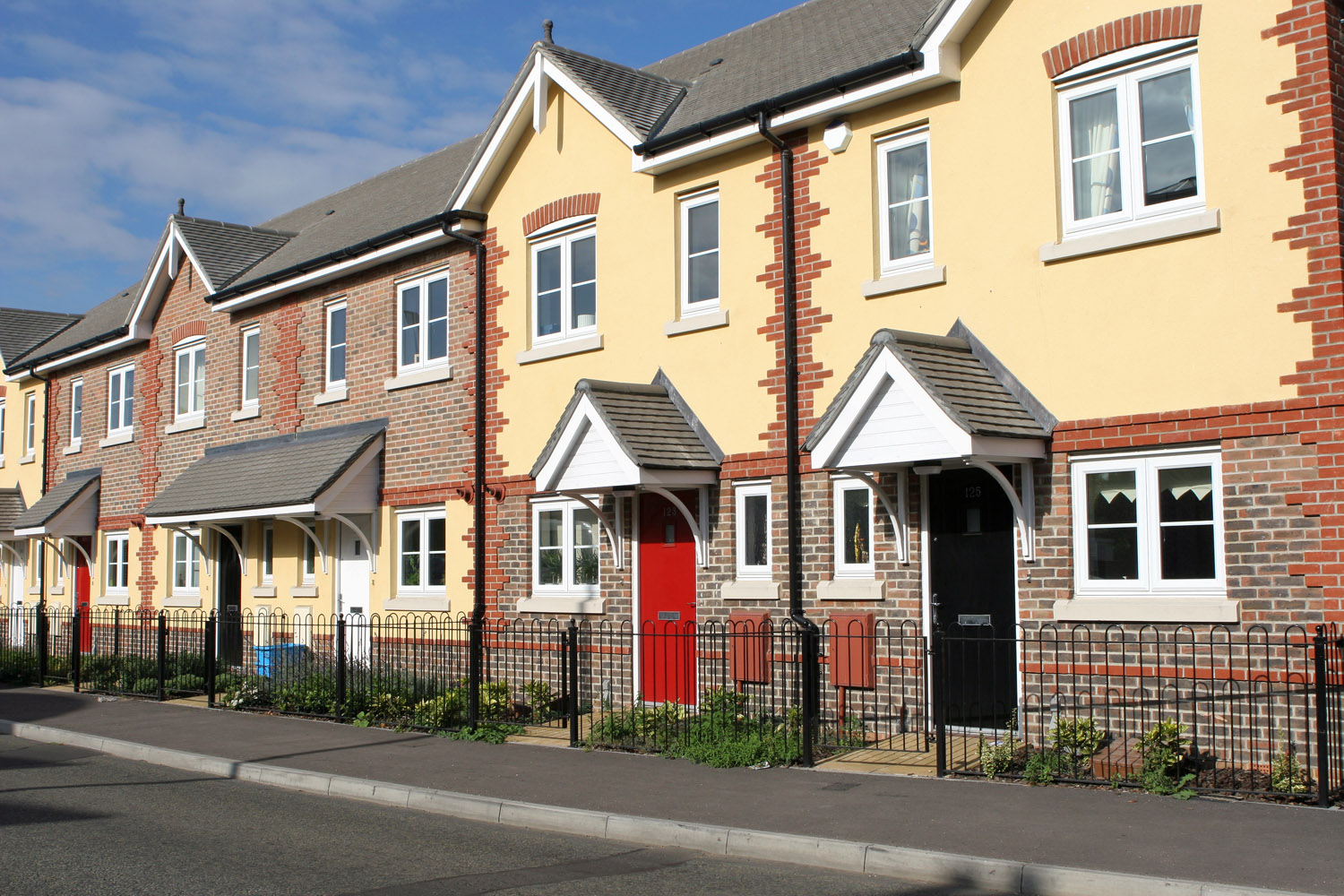 When I worked as a professional economist at HM Treasury and later the Council of Mortgage Lenders (now part of UK Finance), I would regularly brief on the state of the affordability of housing, with a particular focus on the owner-occupied market. That was back in the late 1990s. Fast forward a quarter of a century and I recognise not only how much I have aged but also how deep-rooted and long-standing the affordability problem is.
When I worked as a professional economist at HM Treasury and later the Council of Mortgage Lenders (now part of UK Finance), I would regularly brief on the state of the affordability of housing, with a particular focus on the owner-occupied market. That was back in the late 1990s. Fast forward a quarter of a century and I recognise not only how much I have aged but also how deep-rooted and long-standing the affordability problem is.
It is perhaps not surprising that in her first speech as the new Chancellor of the Exchequer, Rachel Reeves, referenced directly the housing market and the need to address supply-side issues. She has set a target of one and a half million new homes built over the next five years.
It is therefore timely to revisit the trends in house prices across the UK. By applying the distinction between nominal and real values we get a very clear sense of the deteriorating affordability of housing.
Nominal house price patterns
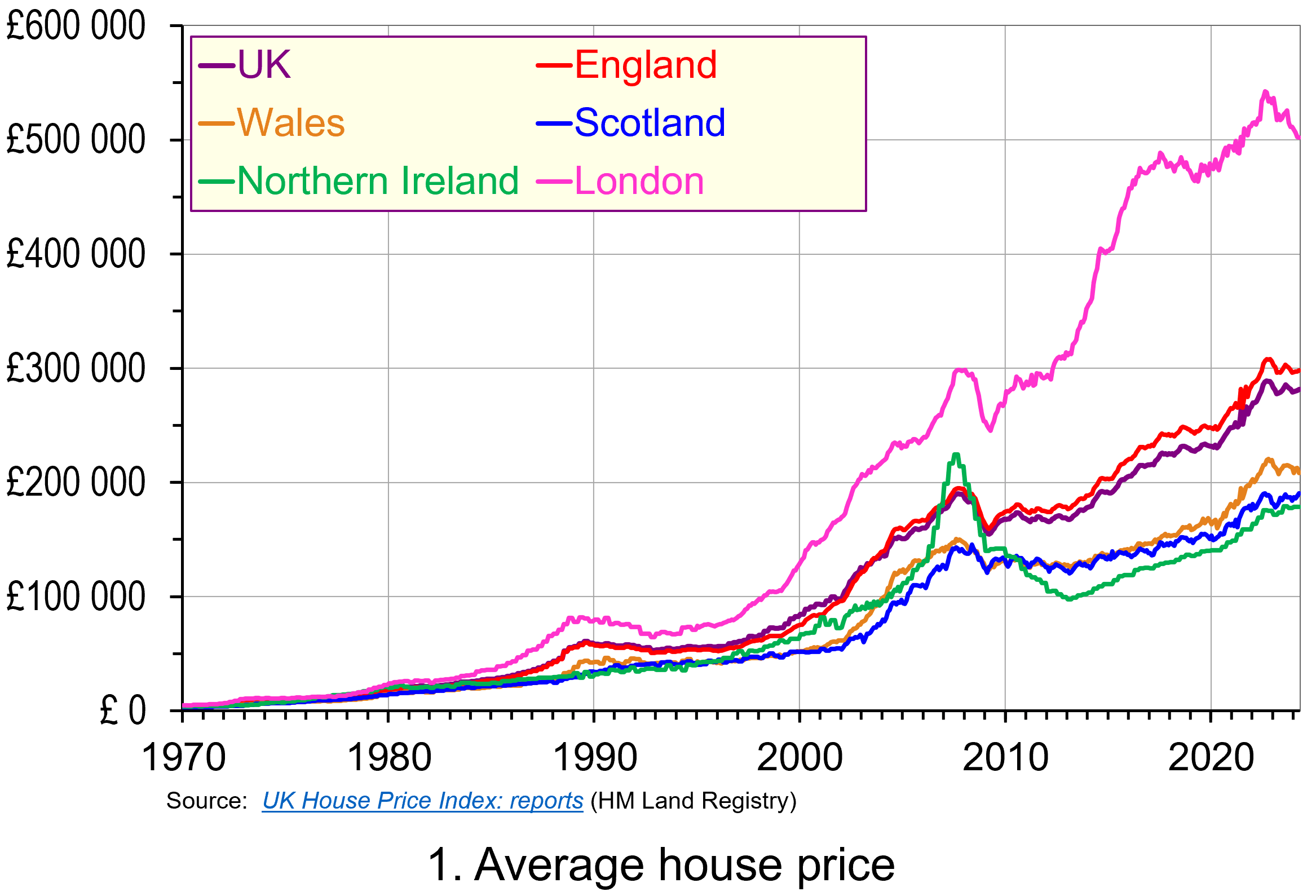 The average UK actual or nominal house price in April 2024 was £281 000. As Chart 1 shows, this masks considerable differences across the UK. In England the average price was £298 000 (105 per cent of the UK average), though this is heavily skewed by London where the average price was £502 000 (178 per cent of the UK average). Meanwhile, in Scotland it was £190 000 (68 per cent of the UK average), in Wales £208 000 (74 per cent of the UK average) and in Northern Ireland it was £178 000 (74 per cent of the UK average). (Click here to download a PowerPoint copy of the chart.)
The average UK actual or nominal house price in April 2024 was £281 000. As Chart 1 shows, this masks considerable differences across the UK. In England the average price was £298 000 (105 per cent of the UK average), though this is heavily skewed by London where the average price was £502 000 (178 per cent of the UK average). Meanwhile, in Scotland it was £190 000 (68 per cent of the UK average), in Wales £208 000 (74 per cent of the UK average) and in Northern Ireland it was £178 000 (74 per cent of the UK average). (Click here to download a PowerPoint copy of the chart.)
A simple comparison of the average house price in April 2024 with January 1970 reveals a 72-fold increase in the UK, an 80-fold increase in England, including a 101-fold increase in London, a 65-fold increase in Wales, a 59-fold increase in Scotland and a 45-fold increase in Northern Ireland. Whilst these figures are sensitive to the particular period over which we choose to measure, there is little doubting that upward long-term trend in house prices.
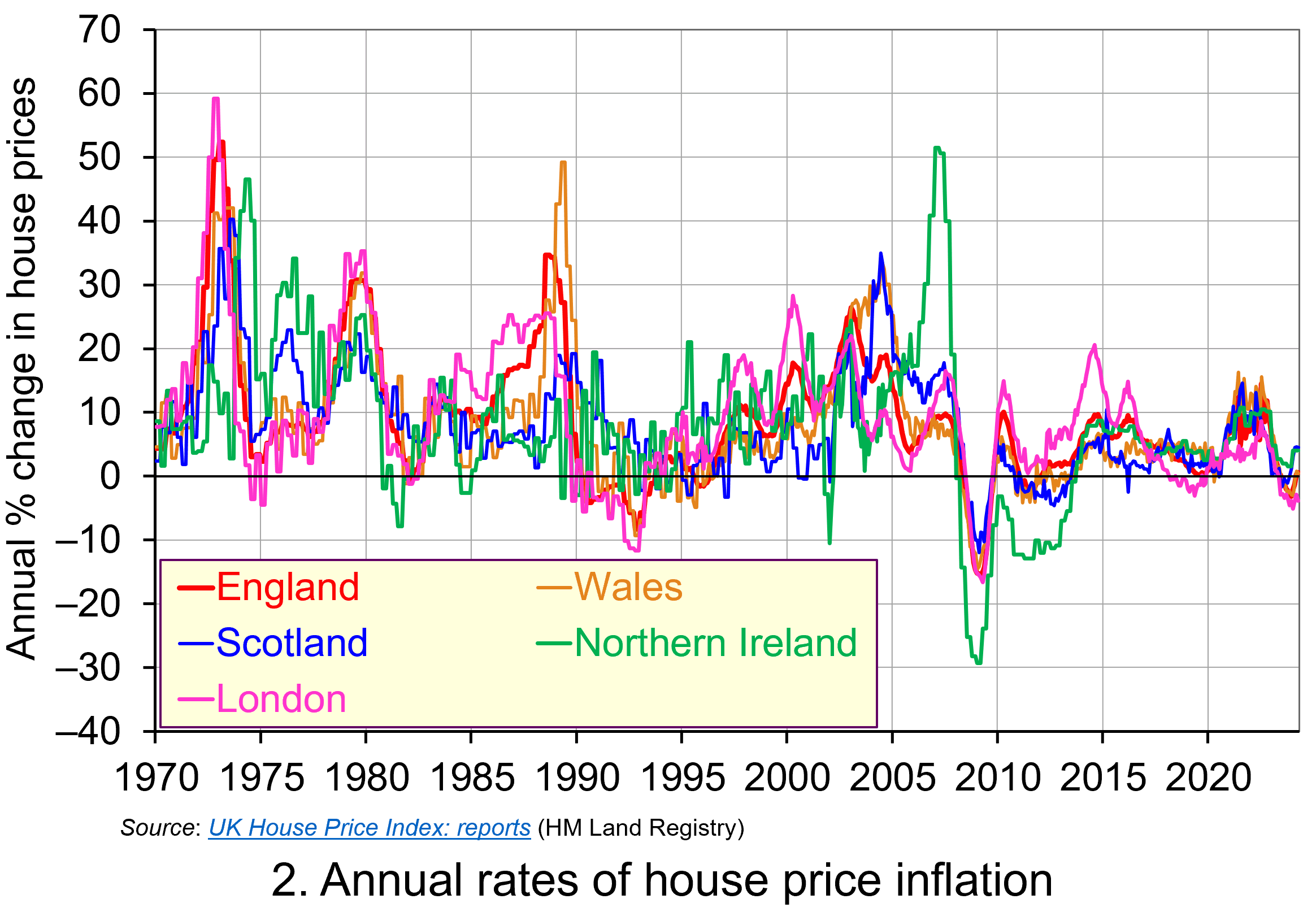 Whilst nominal prices trend upwards over time, the short-term rates of increase are highly volatile. This can be seen from an inspection of Chart 2, which shows the annual rates of increase across the four nations of the UK, as well as for London. This is evidence of frequent imbalances between the flows of property on to the market to sell (instructions to sell) and the number of people looking to buy (instructions to buy). An increase in instructions to buy (housing demand) relative to those to sell (housing supply) puts upward pressure on prices; an increase in the number of instructions to sell (housing supply) relative to those to buy (housing demand) puts downward pressure on prices. (Click here to download a PowerPoint copy of the chart.)
Whilst nominal prices trend upwards over time, the short-term rates of increase are highly volatile. This can be seen from an inspection of Chart 2, which shows the annual rates of increase across the four nations of the UK, as well as for London. This is evidence of frequent imbalances between the flows of property on to the market to sell (instructions to sell) and the number of people looking to buy (instructions to buy). An increase in instructions to buy (housing demand) relative to those to sell (housing supply) puts upward pressure on prices; an increase in the number of instructions to sell (housing supply) relative to those to buy (housing demand) puts downward pressure on prices. (Click here to download a PowerPoint copy of the chart.)
Chart 2 nicely captures the recent slowdown in the housing market. The inflationary shock that began to take hold in 2021 led the Bank of England to raise Bank Rate on 15 occasions – from 0.25 per cent in December 2021 to 5.25 per cent in August 2023 (which remains the rate at the time of writing, but could be cut at the next Bank of England meeting on 1 August 2024). Higher Bank Rate has pushed up mortgage rates, which has contributed to an easing of housing demand. Demand has also been dampened by weak growth in the economy, higher costs of living and fragile consumer confidence. The result has been a sharp fall in the rate of house price inflation, with many parts of the UK experiencing house price deflation. As the chart shows, the rate of deflation has been particularly pronounced and protracted in London, with house prices in January 2024 falling at an annual rate of 5.1 per cent.
Real house price patterns
Despite the volatility in house prices, such as those of recent times, the longer-term trend in house prices is nonetheless upwards. To understand just how rapidly UK house prices have grown over time, we now consider their growth relative to consumer prices. This allows us to analyse the degree to which there has been an increase in real house prices.
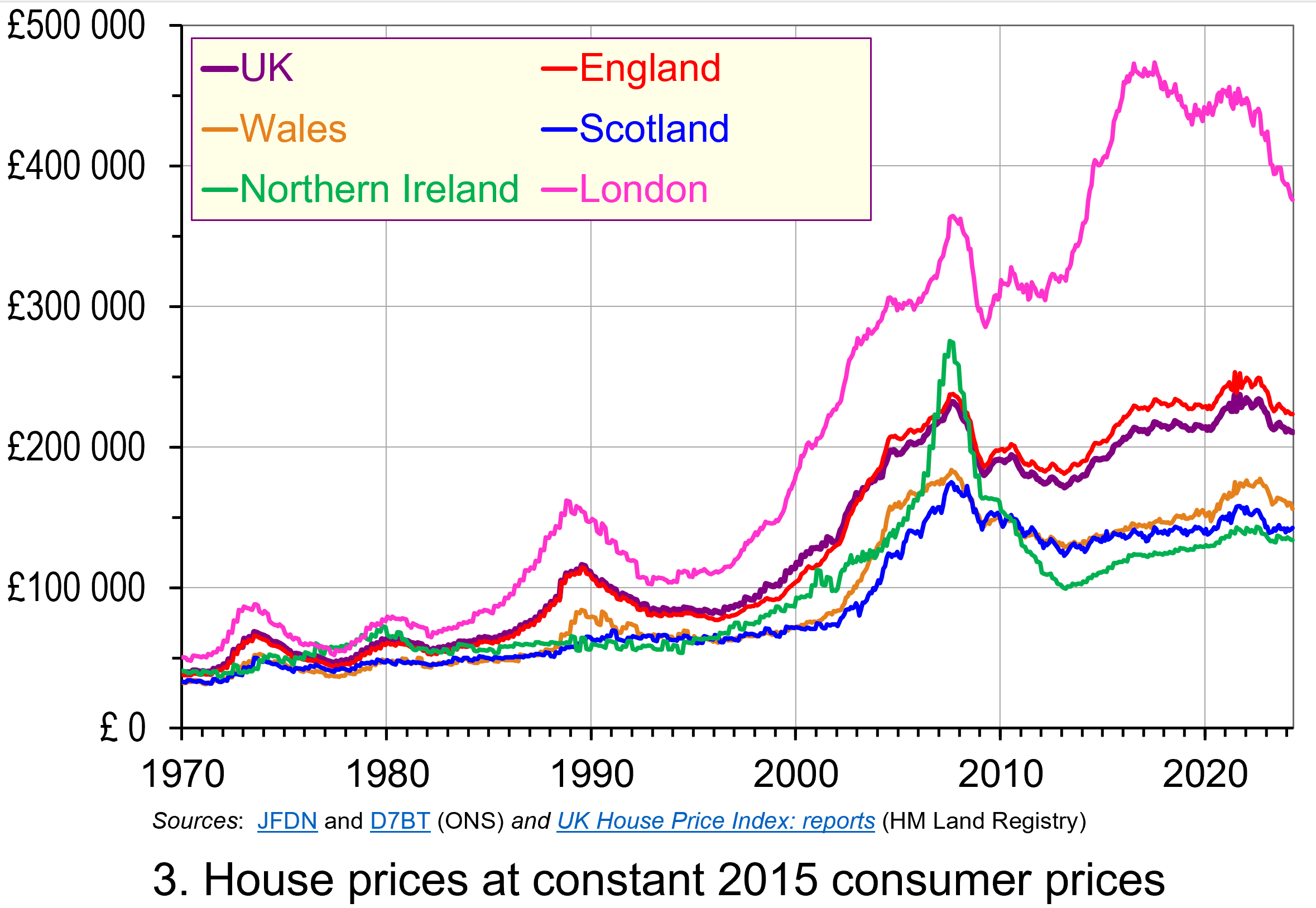 To calculate real or inflation-adjusted house prices, we deflate nominal house prices by the Consumer Prices Index (CPI). Chart 3 shows the resulting real house prices series across the UK as if consumer prices were fixed at 2015 levels.
To calculate real or inflation-adjusted house prices, we deflate nominal house prices by the Consumer Prices Index (CPI). Chart 3 shows the resulting real house prices series across the UK as if consumer prices were fixed at 2015 levels.
The key message here is that over the longer-term we cannot fully explain the growth in actual (nominal) house prices by the growth in consumer prices. Rather, we see real increases in house prices. Inflation-adjusted UK house prices were 5.3 times higher in April 2024 compared to January 1970. For England the figure was 5.9 times, Wales 4.8 times, Scotland 4.3 times and for Northern Ireland 3.3 times. In London, inflation-adjusted house prices were 7.4 times higher. (Click here to download a PowerPoint copy of the chart.)
As we saw with nominal house prices, the estimated long-term increase in real house prices is naturally sensitive to the period over which we measure. For example, the average real UK house price in August 2022 was 5.8 times higher than in January 1970, while in London they were 8.7 times higher. But the message is clear – the long-term increase is not merely nominal, reflecting increasing prices generally, but is real, reflecting pressures that are increasing house prices relative to general price levels.
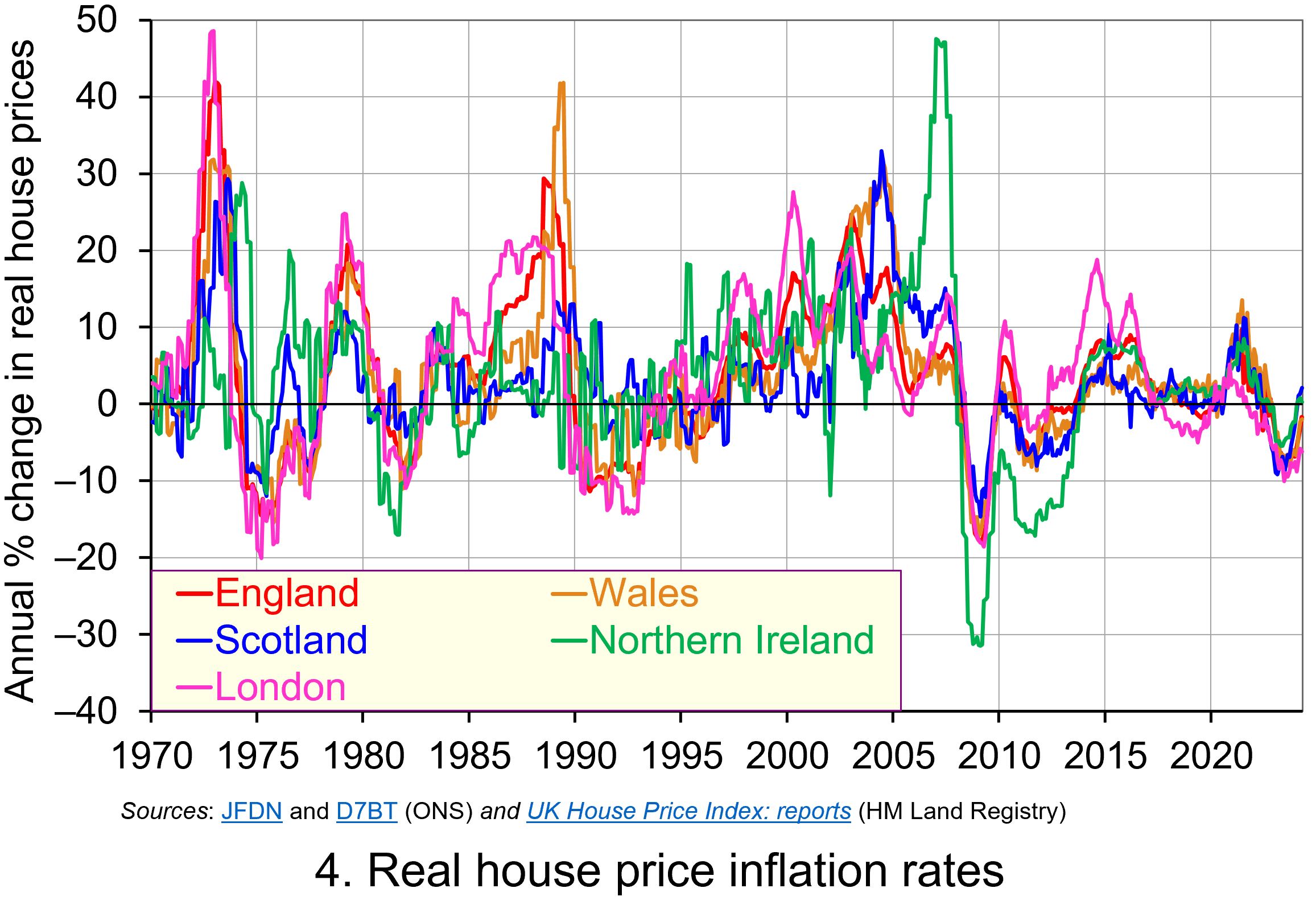 Chart 4 shows how the volatility in house prices continues to be evident when house prices are adjusted for changes in consumer prices. The UK’s annual rate of real house price inflation was as high as 40 per in January 1973; on the other hand, in June 1975 inflation-adjusted house prices were 15 per cent lower than a year earlier. (Click here to download a PowerPoint copy of the chart.)
Chart 4 shows how the volatility in house prices continues to be evident when house prices are adjusted for changes in consumer prices. The UK’s annual rate of real house price inflation was as high as 40 per in January 1973; on the other hand, in June 1975 inflation-adjusted house prices were 15 per cent lower than a year earlier. (Click here to download a PowerPoint copy of the chart.)
Over the period from January 1970 to April 2024, the average annual rate of real house price inflation in the UK was 3.2 per cent. Hence house prices have, on average, grown at an annual rate of consumer price inflation plus 3.2 per cent. For the four nations, real house price inflation has averaged 3.8 per cent in England, 3.4 per cent in Wales, 3.0 per cent in Scotland and 2.9 per cent in Northern Ireland. Further, the average rate of real house price inflation in London since January 1970 has been 4.5 per cent. By contrast, that for the East and West Midlands has been 3.7 and 3.5 per cent respectively. The important point here is that the pace with which inflation-adjusted house prices have risen helps to contextualise the extent of the problem of housing affordability – a problem that only worsens over time when real incomes do not keep pace.
House building
 The newly elected Labour government has made the argument that it needs to prioritise planning reform as an engine for economic growth. While this ambition extends beyond housing, the scale of the supply-side problem facing the housing market can be seen in Chart 5. The chart shows the number of housing completions in the UK since 1950 by type of tenure. (Click here to download a PowerPoint copy of the chart.)
The newly elected Labour government has made the argument that it needs to prioritise planning reform as an engine for economic growth. While this ambition extends beyond housing, the scale of the supply-side problem facing the housing market can be seen in Chart 5. The chart shows the number of housing completions in the UK since 1950 by type of tenure. (Click here to download a PowerPoint copy of the chart.)
The chart shows the extent of the growth in house building in the UK that occurred from the 1950s and into the 1970s. Over these three decades the typical number of new properties completed each year was around 320 000 or 6 per thousand of the population. The peak of house building was in the late 1960s when completions exceeded 400 000 per year or over 7.5 per thousand of the population. It is also noticeable how new local authority housing (‘council houses’) played a much larger role in the overall housing mix.
Since 1980, the average number of housing completions each year has dropped to 191 000 or 3.2 per thousand of the population. If we consider the period since 2000, the number of completions has averaged only 181 000 per year or 2.9 per thousand of the population. While it is important to understand the pressures on housing demand in any assessment of the growth in real house prices, the lack of growth in supply is also a key factor. The fact that less than half the number of properties per thousand people are now being built compared with half a century or so ago is an incredibly stark statistic. It is a major determinant of the deterioration of housing affordability.
However, there are important considerations around the protection of the natural environment that need to be considered too. It will therefore be interesting to see how the reforms to planning develop and what their impact will be on house prices and their affordability.
Articles
- Rachel Reeves requests urgent assessment of spending inheritance
The Guardian, Larry Elliott (8/7/24)
- Reeves to bring back housebuilding targets
BBC News, Faisal Islam and Daniel Thomas (8/7/24)
- UK Chancellor Reeves Vows to Fix Broken Planning System for Housebuilding
Bloomberg UK, Tom Rees, Damian Shepherd, and Joe Mayes (8/7/24)
- What to expect for house prices for the rest of 2024
i News, Callum Mason (10/7/24)
- UK house prices still unaffordable for many people, says Nationwide
The Guardian, Richard Partington (1/7/24)
- House prices still unaffordable for the average earner despite wage rises – Nationwide
Sky News, Sarah Taaffe-Maguire (1/7/24)
- Labour cannot build 1.5m homes without cash for affordable housing, providers say
The Guardian, Jack Simpson (12/7/24)
Statistics
Questions
- Explain the difference between a rise in the rate of house price inflation a rise in the level of house prices.
- Explain the difference between nominal and real house prices.
- If nominal house prices rise can real house price fall? Explain your answer.
- What do you understand by the terms instructions to buy and instructions to sell?
- What factors are likely to affect the levels of instructions to buy and instructions to sell?
- How does the balance between instructions to buy and instructions to sell affect house prices?
- How can we differentiate between different housing markets? Illustrate your answer with examples.
- What metrics could be used to measure the affordability of housing?
- Discuss the argument that the deterioration of housing affordability is the result of market failure.
 UK house prices have been falling in recent months. According to the Nationwide Building Society, average UK house prices in September 2023 were 5.3% lower than in September 2022. This fall reflects the increasing cost of owning a home as mortgage rates have risen. The average standard variable rate mortgage was 3.61% in August 2021, 4.88% in August 2022 and 7.85% in August 2023. A two-year fixed rate mortgage with a 10% deposit had an interest rate of 2.48% in August 2021, 3.93% in August 2022 and 6.59% in August 2023. Thus over two years, mortgage rates have more than doubled. This has made house purchase less affordable and has dampened demand.
UK house prices have been falling in recent months. According to the Nationwide Building Society, average UK house prices in September 2023 were 5.3% lower than in September 2022. This fall reflects the increasing cost of owning a home as mortgage rates have risen. The average standard variable rate mortgage was 3.61% in August 2021, 4.88% in August 2022 and 7.85% in August 2023. A two-year fixed rate mortgage with a 10% deposit had an interest rate of 2.48% in August 2021, 3.93% in August 2022 and 6.59% in August 2023. Thus over two years, mortgage rates have more than doubled. This has made house purchase less affordable and has dampened demand.
But do house prices simply reflect current affordability? Given the large increase in mortgage costs and the cost-of-living crisis, it might seem surprising that house prices have fallen so little. After all, from September 2019 to August 2023, the average UK house price rose by 27.1% (from £215 352 to £273 751). Since then it has fallen by only 5.8% (to £257 808 in September 2023). However, there are various factors that help to explain why house prices have not fallen considerably more.
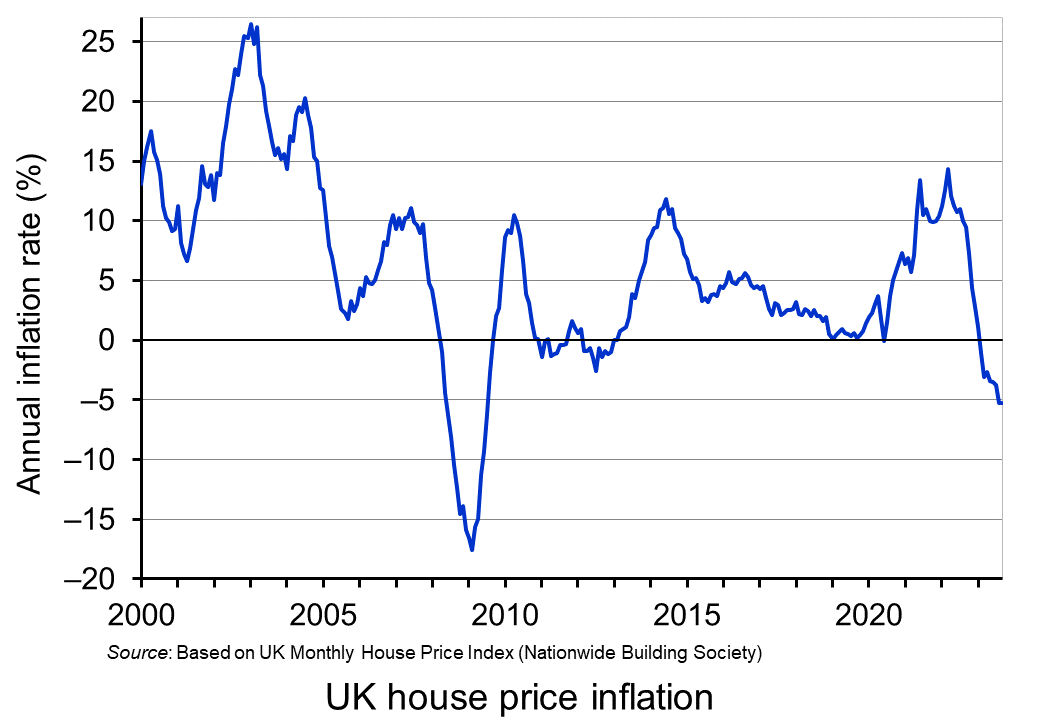 The first is that 74% of borrowers are on fixed-rate mortgages and 96% of new mortgages since 2019 have been at fixed rates. More than half of people with fixed rates have not yet had to renew their mortgage since interest rates began rising in December 2021. These people, therefore, have not yet been affected by the rise in mortgage interest rates.
The first is that 74% of borrowers are on fixed-rate mortgages and 96% of new mortgages since 2019 have been at fixed rates. More than half of people with fixed rates have not yet had to renew their mortgage since interest rates began rising in December 2021. These people, therefore, have not yet been affected by the rise in mortgage interest rates.
The second is that interest rates are expected to peak and then fall. Even though by December 2024 another 2 million households will have had to renew their mortgage, those taking out new longer-term fixed rates may find that rates are lower than those on offer today. This could help to reduce the downward effect on house prices.
The third is that rents continue to rise, partly in response to the higher mortgage rates paid by landlords. With the price of this substitute product rising, this acts as an incentive for existing homeowners not to sell and existing renters to buy, even though they are facing higher mortgage payments.
The fourth is that house prices do not necessarily reflect the overall market equilibrium. People selling may hold out for a better price, hoping that they will eventually attract a buyer. Houses thus are taking longer to sell. This creates a glut of houses at above-equilibrium prices, with fewer sales taking place. At the same time, these higher prices depress demand. People would rather wait for a fall in house prices than pay the current asking price. This creates more of a ‘buyers’ market’, with some sellers being forced to sell well below the asking price. According to Zoopla (see linked article below), the average selling price is 4.2% below the asking price – the highest since 2019. Nevertheless, with sellers holding out and with reduced sales, actual sale prices have fallen less than if markets cleared.
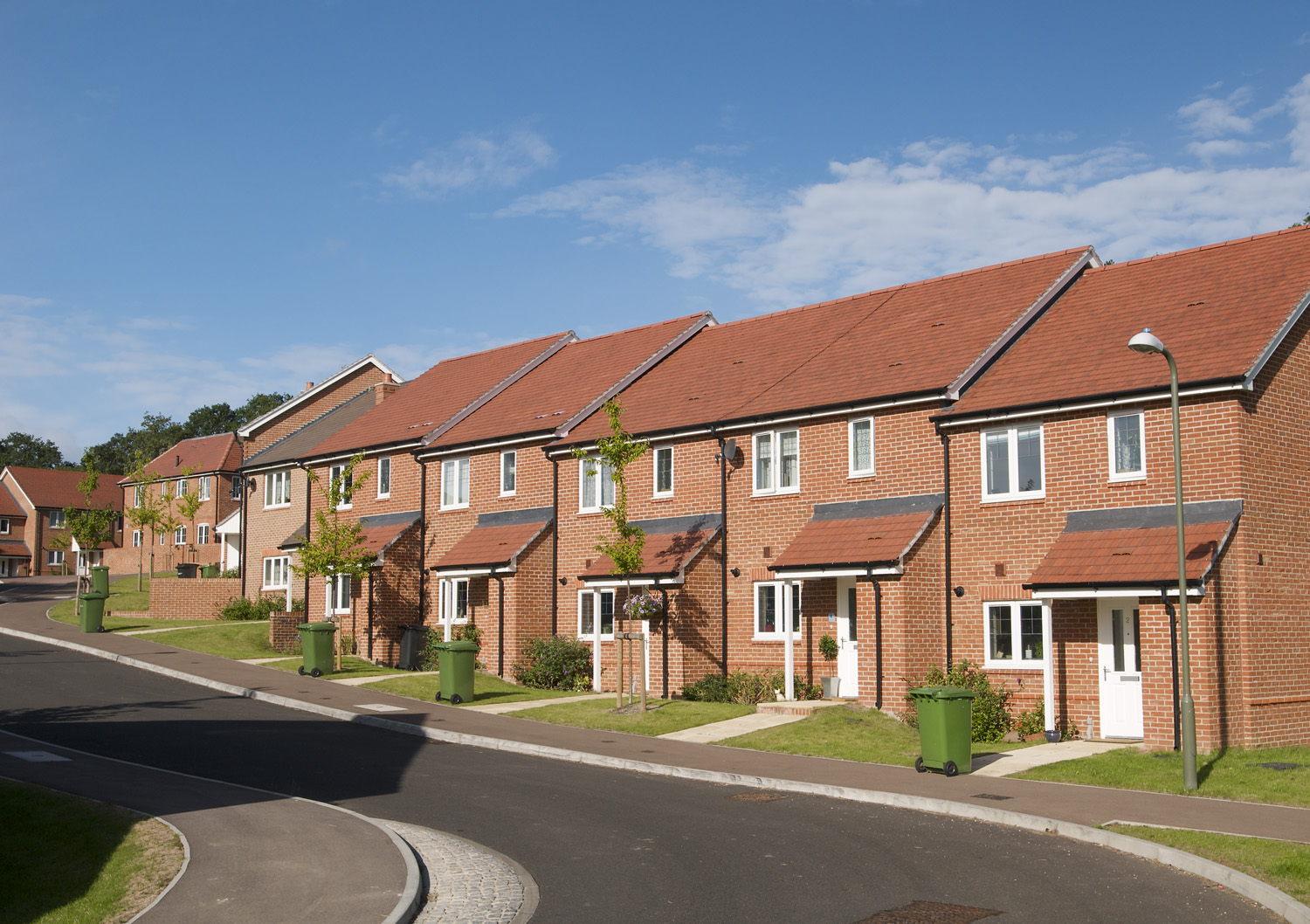 So will house prices continue to fall and will the rate of decline accelerate? This depends on confidence and affordability. With interest rates falling, confidence and affordability are likely to rise. This will help to arrest further price falls.
So will house prices continue to fall and will the rate of decline accelerate? This depends on confidence and affordability. With interest rates falling, confidence and affordability are likely to rise. This will help to arrest further price falls.
However, with large numbers of people still on low fixed rates but with these fixed terms ending over the coming months, for them interest rates will be higher and this could continue to have a dampening effect on demand. What is more, affordability is likely to rise only slowly and in the short term could fall further. Petrol and diesel prices remain high and home energy costs and food prices are still well above the levels of two years ago. Inflation generally is coming down only slowly. The higher prices plus a rising tax burden from fiscal drag1 will continue to squeeze household budgets. This will reduce the size of deposits and the monthly payments that house purchasers can afford.
Over the longer term, house prices are set to rise again. Lower interest rates, rising real incomes again and a failure of house building to keep up with the growth in the number of people seeking to buy houses will all contribute to this. However, over the next few months, house prices are likely to continue falling. But just how much is difficult to predict. A lot will depend on expectations about house prices and incomes, how quickly inflation falls and how quickly the Bank of England reduces interest rates.
1 With tax thresholds frozen, as people’s wages rise, so a higher proportion of their income is taxed and, for higher earners, a higher proportion is taxed at a higher rate. This automatically increases income tax as a proportion of income.
Articles
- House Price Index – September 2023
Zoopla, Richard Donnell (28/9/23)
- UK home sellers increase discounts to secure deals, Zoopla data shows
Financial Times, Joshua Oliver (28/9/23)
- Buyer’s market! House hunters bag £12k off average asking price, says Zoopla
This is Money, Jane Denton (28/9/23)
- House price growth remained weak in September
Nationwide HPI Reports (2/10/23)
- UK mortgage approvals hit six-month low as interest rates cool market
The Guardian, Phillip Inman (29/9/23)
- UK house prices are plummeting at the most rapid pace in over a decade
Euronews, Daniel Harper (2/10/23)
- House prices fall across all UK regions for first time since 2009
Financial Times, Valentina Romei (2/10/23)
- Will house prices fall in 2023?
The Times, Hannah Smith and Georgie Frost (4/10/23)
- First-time buyers in UK drop by a fifth as higher mortgage costs bite
The Guardian, Julia Kollewe (27/9/23)
- England worst place in developed world to find housing, says report
The Guardian, Robert Booth (5/10/23)
- UK homeowners face huge rise in payments when fixed-rate mortgages expire
The Guardian, Richard Partington (17/6/23)
- UK house prices: Where the cheapest areas to buy are, and how far prices could fall
i News, Zesha Saleem (29/9/23)
- Why are house prices falling?
Independent, Vicky Shaw (7/9/23)
Data
Questions
- Use a supply and demand diagram to illustrate the situation where house prices are above the equilibrium.
- Why does house price inflation/deflation differ (a) from one type of house (or flat) to another; (b) from one region of the economy/locality to another?
- Find out why house prices rose so much (a) in the early 2000s; (b) from 2020 to 2022.
- Find out why house prices fell so much from 2008 to 2010. Why was this fall so much greater than in recent months?
- Find out what is happening to house prices in two other developed countries of your choice. How does the current housing market in these countries differ from that in the UK?
- Paint possible scenarios (a) where UK house prices continue to fall by several percentage points; (b) begin to rise again very soon.
 This is the second of three blogs looking at high inflation and its implications. Here we look at changes in the housing market and its effects on households. Another way of analysing the financial importance of the housing and mortgage markets is through the balance sheets and associated flow accounts of the household sector.
This is the second of three blogs looking at high inflation and its implications. Here we look at changes in the housing market and its effects on households. Another way of analysing the financial importance of the housing and mortgage markets is through the balance sheets and associated flow accounts of the household sector.
We used the concept of balance sheets in our blog Bank failures and the importance of balance sheets. In the blog we referred to the balance-sheet effects from interest rate hikes on the financial well-being of financial institutions.
The analysis is analogous for households. Again, we can identify two general effects: rising borrowing and debt-servicing costs, and easing asset prices.
The following table shows the summary balance sheet of the UK household sector in 1995 and 2021.

Source: National balance sheet estimates for the UK: 1995 to 2021 (January 2023) and series RPHA, ONS
The total value of the sector’s net wealth (or ‘worth’) is the sum of its net financial wealth and its non-financial assets. The former is affected by the value of the stock of outstanding mortgages, which we can see from row 3 in the table (‘loans secured on dwellings’) has increased from £390 billion in 1995 to £1.56 trillion in 2021. This is equivalent to an increase from 70 to 107 per cent of the sector’s annual disposable income. This increase helps to understand the sensitivity of the sector’s financial position to interest rate increases and the sizeable cash flow effects. These effects then have implications for the sector’s spending.
 Housing is also an important asset on household balance sheets. The price of housing reflects both the value of dwellings and the land on which they sit, and these are recorded separately on the balance sheets. Their combined balance sheet value increased from £1.09 trillion (£467.69bn + £621.49bn) in 1995 to £6.38 trillion (£1529.87bn + £4853.16bn) in 2021 or from 128% of GDP to 281%.
Housing is also an important asset on household balance sheets. The price of housing reflects both the value of dwellings and the land on which they sit, and these are recorded separately on the balance sheets. Their combined balance sheet value increased from £1.09 trillion (£467.69bn + £621.49bn) in 1995 to £6.38 trillion (£1529.87bn + £4853.16bn) in 2021 or from 128% of GDP to 281%.
The era of low inflation and low interest rates that had characterised the previous two decades or so had helped to boost house price growth and thus the value of non-financial assets on the balance sheets. In turn, this had helped to boost net worth, which increased from £2.78 trillion in 1995 to £12.29 trillion in 2021 or from 319% of GDP to 541%.
Higher interest rates and wealth
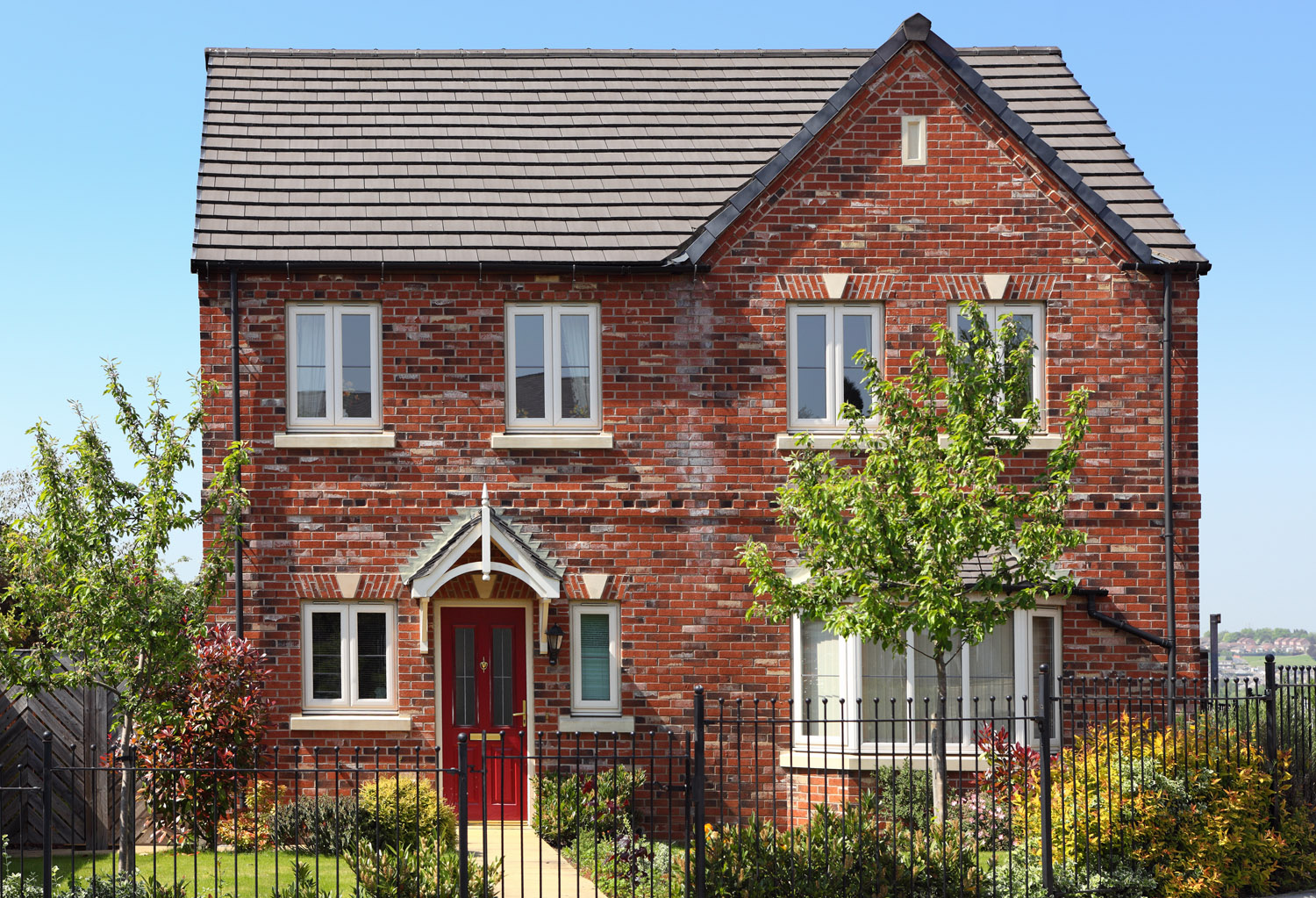 The advent of higher interest rates was expected not only to impact on the debt servicing costs of households but the value of assets, including, in the context of this blog, housing. As Chart 3 in the previous blog helped to show, higher interest rates and higher mortgage repayments contributed to an easing of house price growth as housing demand eased. On the other hand, the impact on mortgaged landlords helped fuel the growth of rental prices as they passed on their increased mortgage repayment costs to tenants.
The advent of higher interest rates was expected not only to impact on the debt servicing costs of households but the value of assets, including, in the context of this blog, housing. As Chart 3 in the previous blog helped to show, higher interest rates and higher mortgage repayments contributed to an easing of house price growth as housing demand eased. On the other hand, the impact on mortgaged landlords helped fuel the growth of rental prices as they passed on their increased mortgage repayment costs to tenants.
Higher interest rates not only affect the value of housing but financial assets such as corporate and government bonds whose prices are inversely related to interest rates. Research published by the Resolution Foundation in July 2023 estimates that these effects are likely to have contributed to a fall in the household wealth from early 2021 to early 2023 by as much as £2.1 trillion.
The important point here is that further downward pressure on asset prices is expected as they adjust to higher interest rates. This and the impact of higher debt servicing costs will therefore continue to impact adversely on general financial well-being with negative implications for the wider macroeconomic environment.
Articles
- The Mortgage Crunch
Resolution Foundation, Simon Pittaway (17/6/23)
- Peaked Interest?
Resolution Foundation, Molly Broome, Ian Mulheirn and Simon Pittaway (17/7/23)
- UK inflation to fall to lowest level since March 2022 but Bank of England still tipped to hike interest rates
City A.M., Jack Barnett (17/7/23)
- Mortgage payments set to jump by £500 for one million households
BBC News, Tom Espiner (13/7/23)
- Interest rates: Big rise less likely after inflation surprise
BBC News, Daniel Thomas, Faisal Islam & Dharshini David (19/7/23)
- Rising Mortgage Costs. What Can Be Done?
NIESR blog, Max Mosley and Adrian Pabst (17/7/23)
- UK interest rates forecast to rise less sharply after inflation falls to 7.9%
The Guardian, Richard Partington (19/7/23)
- Mortgage costs: More Scots falling behind on repayments
Herald Scotland, Kristy Dorsey (18/7/23)
Report
Data
Questions
- What possible indicators could be used to assess the affordability of residential house prices?
- What do you understand by the concept of the monetary policy transmission mechanism? How do the housing and mortgage markets relate to this concept?
- What factors might affect the proportion of people taking out fixed-rate mortgages rather than variable-rate mortgages?
- What is captured by the concept of net worth? Discuss how the housing and mortgage markets affect the household sector’s net worth.
- What are cash-flow effects? How do rising interest rates effect savers and borrowers?
- How might wealth effects from rising interest rates impact younger and older people differently?
- Discuss the ways by which house price changes could affect household consumption.
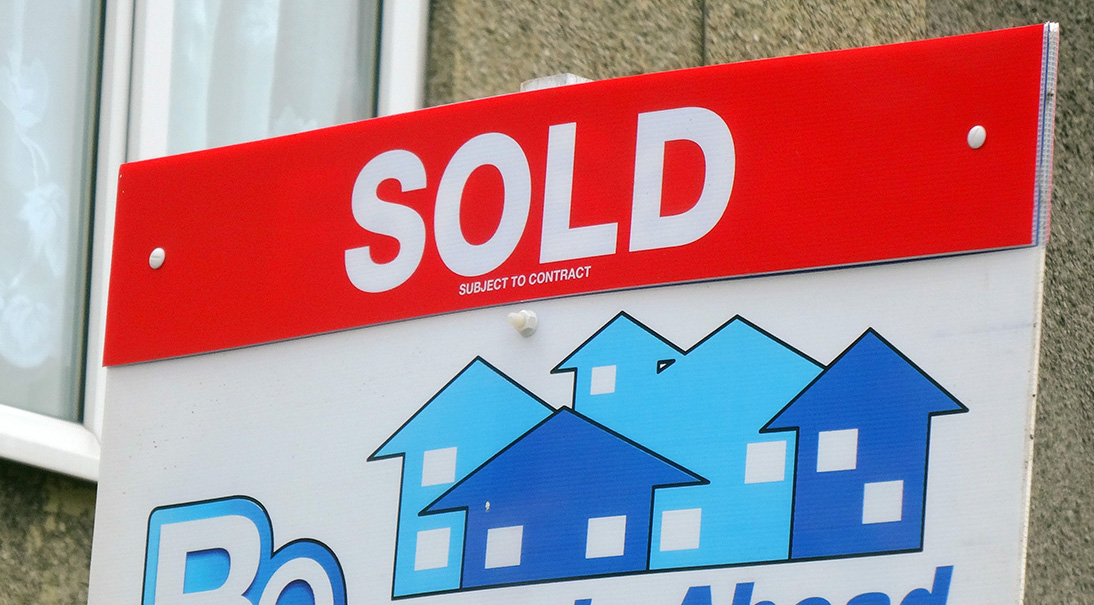 In July this year, the UK saw the highest annual house price inflation rate since May 2003. The housing market is experiencing an excess demand for houses. There is a greater demand from buyers than there are homes for sale. This has led to a double-digit annual rise for the 10th consecutive month. Nationwide building society data show that UK house prices rose by 10% in the year to August 2022, with the typical property price rising by £50 000 in the past two years to £273 751.
In July this year, the UK saw the highest annual house price inflation rate since May 2003. The housing market is experiencing an excess demand for houses. There is a greater demand from buyers than there are homes for sale. This has led to a double-digit annual rise for the 10th consecutive month. Nationwide building society data show that UK house prices rose by 10% in the year to August 2022, with the typical property price rising by £50 000 in the past two years to £273 751.
The market has seen this continued growth in house prices despite the growing pressure on buyers’ budgets. It is even reported that estate agents are seeing a recent surge in activity. However, can the housing market continue to grow, or will we witness a crash?
House market activity
There are also signs that the housing market is now losing some momentum. According to the Nationwide, the average price of a home was £294 260 in August, 0.4% higher than the previous month. Although this marked another record high, the rise was less than earlier in the year. Halifax called the monthly rise ‘relatively modest’ compared with the rapid house price inflation that has been seen in recent times, where the average monthly increase in house prices has been 0.9%. The latest increase marked a return to growth for house prices, after they fell in July for the first time in more than a year.
However, the annual growth did slow in August, despite house prices still growing. The annual rate of house price growth dropped to 11.5% from 11.8% in July – the lowest level in three months. The Nationwide is predicting that an increase in energy costs and rising mortgage interest rates will add to the pressure on household budgets in the coming months. Energy prices are continually rising, and it is suggested that the least energy-efficient properties could typically see bills surge by £2700 a year, or £225 a month. This added squeeze on households’ disposable income, combined with the expectation that that inflation is set to remain in double digits into next year, is predicted to slow house price increases further or even cause them to fall.
Barratt Developments, the country’s biggest housebuilder, stated that the number of homes reserved each week until the end of August had fallen below the level of a year earlier, and was now lower than before the coronavirus pandemic. This has been partly driven by people anticipating further rises in interest rates and provides further evidence of a slowdown in the housing market.
Bank of England decisions on interest rates
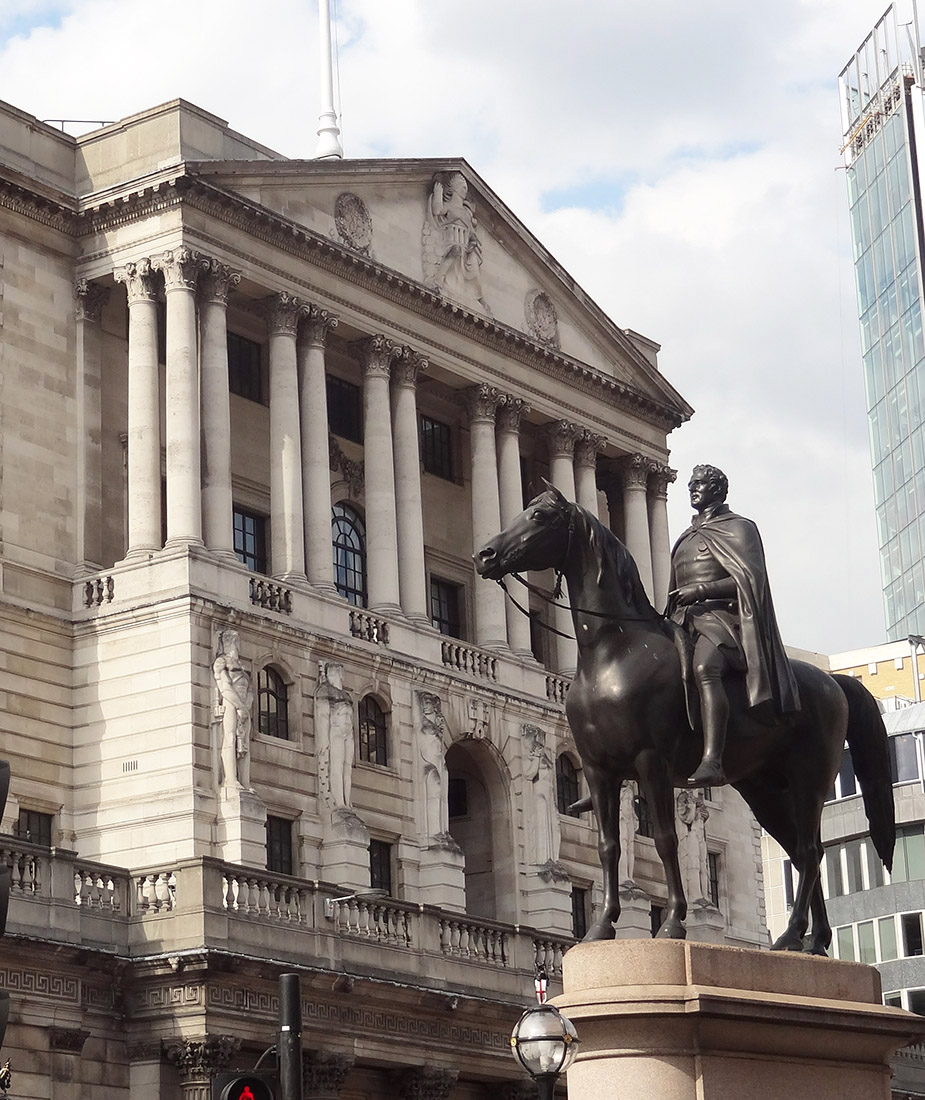 In early August, the Bank of England announced its biggest increase in interest rates in 27 years, taking the UK base rate from 1.25% to 1.75%, a 13-year high. This rise in the base rate, which has a knock-on effect on other interest rates, was an attempt to control rising inflation as energy and food prices soared.
In early August, the Bank of England announced its biggest increase in interest rates in 27 years, taking the UK base rate from 1.25% to 1.75%, a 13-year high. This rise in the base rate, which has a knock-on effect on other interest rates, was an attempt to control rising inflation as energy and food prices soared.
Then, on Thursday 22nd September, the Bank of England announced a further 0.5 percentage point rise in the base rate to 2.25%. This is now the highest level for 14 years, but this is unlikely to be the peak as it is expected that the Bank will continue raising rates into next year.
The government’s mini-Budget on 23 September involved a price cap on energy prices, estimated to cost around £150 billion, and various tax cuts. The package would be funded largely by borrowing. This is likely to drive interest rates up further. Indeed, in response to the package, the interest rate on new government bonds soared and price of existing bonds (which pay a fixed amount per annum) correspondingly fell, thereby increasing their yield. Yields rose above 4%; they were just 1.3% rate at the start of the year.
These further increases in interest rates will have a negative impact on the market as they feed through to mortgage rates, which have already increased noticeably recently. Indeed, following the mini-Budget and the rise in bond prices, around half the mortgage products on offer to new buyers or those re-mortgaging were withdrawn. Many households with mortgages will thus see their costs rise. Experts have warned that borrowers in the UK are especially exposed, with many people having mortgages tracking central bank rates or having short-term fixed deals set to expire. Those on fixed-rate deals will not be immediately affected, although their costs could jump when their deals come up for renewal.
The impact of a recession
Even though the housing market is slowing, it is nowhere near a crash. But, with the Bank of England predicting a recession, there is concern about the impact on the housing market. In August, the Bank had warned that Britain was likely to enter into a recession by December this year and predicted it to last 15 months. However, with the announcement of higher interest rates, the Bank now warns that the UK may already be in a recession. The central bank had previously expected the economy to grow between July and September, but it now believes it will have shrunk by 0.1%. This comes after the economy already shrank slightly between April and June.
A recession is defined as when an economy shrinks for two consecutive quarters. During a recession, house prices typically flatline or decrease but it all depends on how severe the recession is. Historically, when there is a deep and prolonged contraction in the economy with rising unemployment, house prices tend to fall.
Finance experts have predicted that the UK will suffer its longest downturn since the 2008 financial crisis. The global financial crisis saw the availability of mortgage finance contract, making it much harder for people to borrow, thereby reducing the demand for homes. This, together with rising unemployment, resulted in average house prices falling by 12%. It was not until 2010 that the housing market in London began to recover and not until 2013 in the wider UK market.
The BoE’s Monetary Policy Committee (MPC) have warned:
Real household post-tax income is projected to fall sharply in 2022 and 2023, while consumption growth turns negative.
This will be the first recession in the UK since the height of the Covid crisis 2020. However, then the housing market didn’t behave in the typical way and property prices continued rising. This was fuelled by people working from home, which encouraged both house movers and first-time buyers to seek houses with sufficient space. The housing market has been rampant ever since as people have taken advantage of low interest rates and also of the stamp duty holiday between July 2020 and September 2021 (see the blog, The red hot housing market).
This time, however, the predicted recession could finally put the brakes on growing house prices as people’s real incomes fall. With people faced with higher mortgage rates and the cost-of-living squeeze, the growth in demand for property is likely to slow rapidly: to 5% in the second half of this year and then lower still in 2023. This could eventually match the supply of property. Supply may also increase as a result of an increase in repossessions as people struggle to pay their monthly mortgage bills.
Cuts to stamp duty
In his mini-Budget on 23 September, the new Chancellor, Kwasi Kwarteng, announced that stamp duty on house purchases would be cut. The threshold at which buyers have to start paying the duty would rise from £125 000 to £250 000 and first-time buyers would not pay any duty on the first £425 000.
This cut in tax on house purchase will go some way to offsetting the effect of rising mortgage interest rates and is likely to reduce the slowdown in house price rises.
First time buyers
A recession could actually help some people climb onto the property ladder if it pushes property prices down. That would lead to smaller deposits being needed and lower total amounts having to be borrowed.
 However, despite the prospect of falling house prices, it still remains tough for first-time buyers. The biggest risk for hopeful homebuyers in a recession is losing their job. At a time of increased uncertainty, some first-time buyers are likely to wait, hoping that homes will become cheaper. However, there have only been 31 months in the past 20 years when house prices have fallen, all of which occurred between 2008 and 2012. Myron Jobson, senior personal finance analyst at Interactive Investor said:
However, despite the prospect of falling house prices, it still remains tough for first-time buyers. The biggest risk for hopeful homebuyers in a recession is losing their job. At a time of increased uncertainty, some first-time buyers are likely to wait, hoping that homes will become cheaper. However, there have only been 31 months in the past 20 years when house prices have fallen, all of which occurred between 2008 and 2012. Myron Jobson, senior personal finance analyst at Interactive Investor said:
Fast-rising rents are not offering any relief and could keep some buyers in the hunt for a home for longer than they would like.
Also, prices are not yet actually falling, even though demand is slowing. Demand for homes is still outstripping the available housing inventory. This means that the market is still a difficult one for first-time buyers and those looking to climb up the property ladder.
At first sight, it may seem that cuts to stamp duty will help first-time buyers, especially as the duty is paid after a higher threshold than for other purchasers. However, the stamp duty cuts will stimulate demand, which, as we argued above, will reduce the slowdown in house price rises. Also, despite the threshold being higher for first-time buyers, by stimulating house price inflation, most if not all the gains in the duty cut could be offset and could risk pricing-out first-time buyers.
Conclusion
The economic outlook is uncertain. However, the rises in the energy price cap in October and beyond, and the general rise on the cost of living as prices rise faster than wages, are expected to increase pressure on household finances, which will limit the amount that prospective house buyers can afford to borrow. As a result, house price inflation is expected to fall across the majority of UK regions, as buyer demand eases. But just how much house price inflation will fall and whether it will turn negative (i.e. a fall in house prices) is hard to predict
Articles
- House price growth at 10% a year despite squeeze on finances
BBC News, Kevin Peachey (1/9/22)
- How will a recession hit the UK housing market?
BBC News, Simon Read (5/8/22)
- Could the UK see interest rates rise to 5%?
BBC News, Faisal Islam (22/9/22)
- UK may already be in recession – Bank of England
BBC News, Dearbail Jordan & Daniel Thomas (22/9/22)
- Mortgage rates: act fast as increases loom
Financial Times, James Pickford (16/9/22)
- Who escapes the great mortgage reset?
Financial Times, Tom Braithwaite (16/9/22)
- UK house prices: Halifax and Barratt warn of challenges ahead
The Guardian, Joanna Partridge (7/9/22)
- Annual rate of UK house price growth doubles to 15.5% in one month
The Guardian, Rupert Jones (14/9/22)
- After an autumn flurry, is the UK housing market going to fall at last?
The Observer, Julia Kollewe (17/9/22)
- Stamp duty cut will benefit UK’s wealthier and raise inflation, say experts
The Guardian, Richard Partington (21/9/22)
- What does Kwarteng’s stamp duty cut mean for UK homebuyers?
The Guardian, Jess Clark (23/9/22)
- What happens to house prices in a recession? A property expert explains
Metro, Jack Slater (13/8/22)
Questions
- With the aid of a diagram, explain the current demand and supply in the housing market.
- How does an expectation of a rise in interest rates affect the demand for housing?
- Define the term recession. Why is the UK likely to enter recession (if it has not already done so)?
- Describe the characteristics of the business cycle during a recession.
- How do expectations of house price increases affect actual house price increases?
 House prices are soaring throughout the world, making them unaffordable for many first-time buyers. In the UK, for example, according to the Nationwide, the annual house price increase was 13.4% in 2021 Q2. In the USA, house prices are rising by over 23% per annum.
House prices are soaring throughout the world, making them unaffordable for many first-time buyers. In the UK, for example, according to the Nationwide, the annual house price increase was 13.4% in 2021 Q2. In the USA, house prices are rising by over 23% per annum.
The reason for this rampant house price inflation is that demand is rising much faster than supply. What is more, with inelastic supply in the short term, a given percentage rise in demand leads to a larger percentage increase in prices.
Reasons for rapidly rising house prices
 But why has demand risen so rapidly? One major reason is that central banks have engaged in massive quantitative easing. This has driven down interest rates to historic lows and has led to huge asset purchases. Mortgage lenders, awash with money, have been able to increase the ratio of lending to income. Borrowing by house purchasers, encouraged by low interest rates and easy access to mortgages, has thus increased rapidly.
But why has demand risen so rapidly? One major reason is that central banks have engaged in massive quantitative easing. This has driven down interest rates to historic lows and has led to huge asset purchases. Mortgage lenders, awash with money, have been able to increase the ratio of lending to income. Borrowing by house purchasers, encouraged by low interest rates and easy access to mortgages, has thus increased rapidly.
Another reason for the increased demand is that economies are beginning to recover from the COVID-induced recessions. This makes people more confident about their future financial positions and more willing to take on increased mortgage debt. Another reason is that, with increased working from home, people are looking for larger houses where rooms can be used as studies. Another is that, with less spending during the lockdowns, people have built up savings, which can be used to buy larger homes.
Some countries have deliberately boosted demand by fiscal measures. In the UK, the government introduced a stamp duty ‘holiday’. Previously a 3% ‘stamp duty’ tax was applied to purchases over £125 000. Under the holiday scheme, the rate would only apply to purchases over £500 000 until 30 June 2021 and then to purchases over £250 000 until 30 September 2021. This massively boosted demand, especially as the deadlines approached. In the USA, there are various schemes at federal and state level to support first-time buyers, including low-interest loans and vouchers. Supporting demand is counterproductive if it merely leads to higher prices and thus does not make it easier for people to buy.
Speculation has played a major part too, with many potential purchasers keen to buy before prices rise further. On the supply side, some vendors have held back hoping to get a higher price by waiting. Gazumping has returned. This is where vendors accept a new higher offer even though they have already accepted a previous lower one.
Effects of higher house prices
Higher house prices have had a knock-on effect on rents, which have also soared. This has encouraged house purchases for rent both by individuals and by property investment companies. The effect of rapidly rising house prices and rents has been to increase the divide in society between property owners and those unable to afford to buy and forced to rent.
Increased housing wealth is likely to lead to greater housing equity withdrawal. This is where people draw on some of their equity in order to finance increased consumer spending, thereby boosting aggregate demand and possibly inflation.
Will the house price boom end soon?
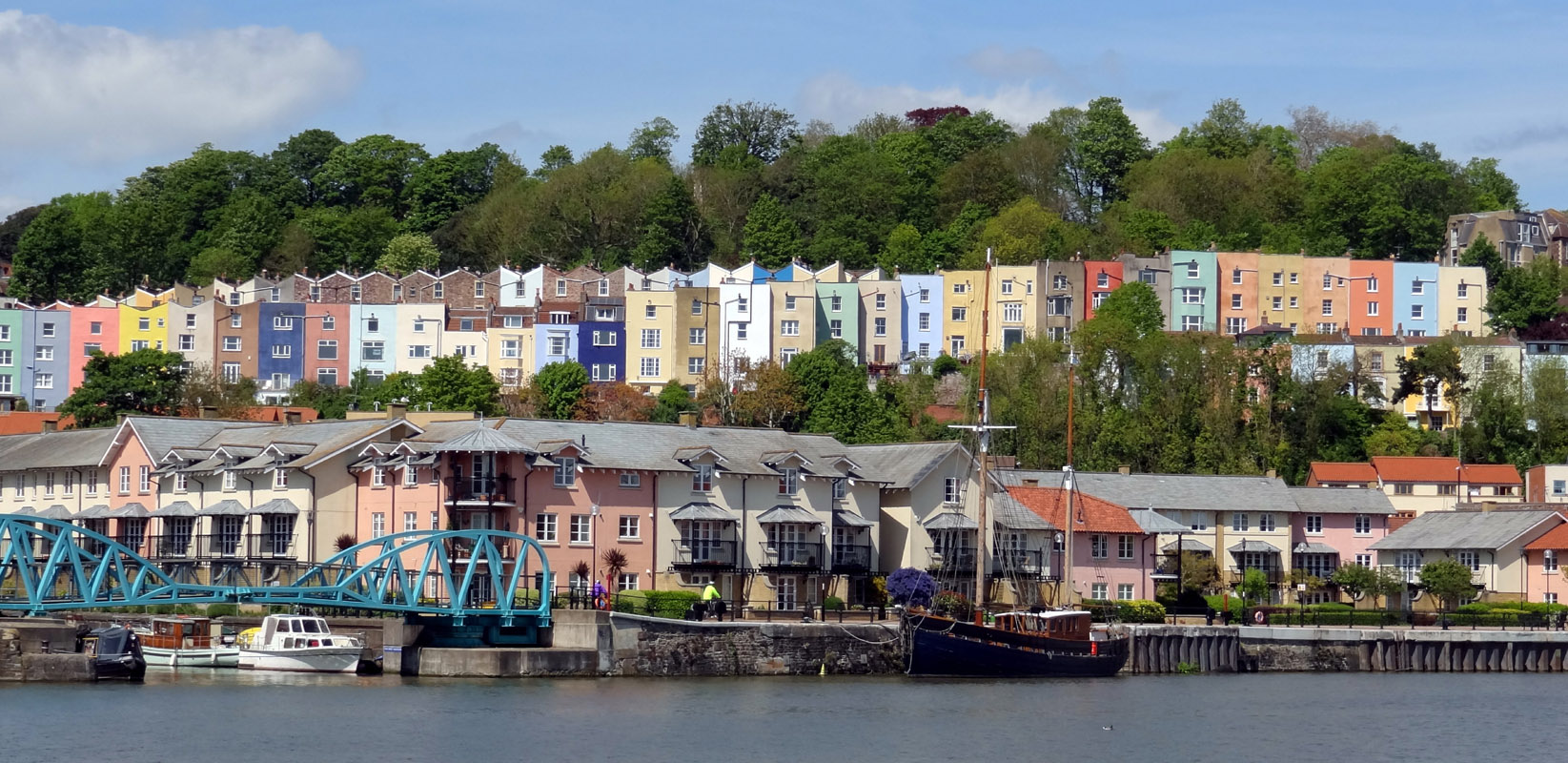 One scenario is that there will be a gradual slowdown in house price increases as quantitative easing is tapered off and as support measures, such as the UK’s stamp duty holiday, are unwound.
One scenario is that there will be a gradual slowdown in house price increases as quantitative easing is tapered off and as support measures, such as the UK’s stamp duty holiday, are unwound.
There is a real possibility, however, that there will be a more severe correction, with house prices actually falling. This could be triggered by central banks raising interest rates in response to higher inflation caused by the recovery and by higher commodity prices. In the UK, labour shortages brought about by Brexit could make the inflationary problem worse. With high levels of mortgage debt, even a half percentage point rise in mortgage interest rates could have a severe effect on demand. Falling house prices will then be compounded by speculation, with buyers holding off and sellers rushing to sell.
Articles
- “UK Boom the Biggest in 50 years” thanks to House Prices, but Oxford Economics Warn of Risks
PoundSterling Live, Gary Howes (18/6/21)
- US house prices see biggest rise in 30 YEARS and are outstripping Britain’s pandemic-fuelled boom: Is a global housing market bubble emerging?
This is Money, Helen Crane (1/7/21)
- House prices: urban exodus of upsizers shifts property demand
Business Telegraph (18/4/21)
- House prices rise at fastest pace in 17 years
BBC News (30/6/21)
- Runaway house prices: the ‘winners and losers’ from the pandemic
Financial Times, Delphine Strauss and Colby Smith (25/6/21)
- World’s Bubbliest Housing Markets Flash 2008 Style Warnings
Bloomberg, Enda Curran (15/6/21)
- House prices climb to record levels in US and Europe
Financial Times, Martin Arnold, Colby Smith and Matthew Rocco (22/6/21)
- With house prices through the roof, young buyers’ hopes go out the window
The Observer, Phillip Inman (3/7/21)
- Is the UK housing bubble about to burst? These are the best and worst scenarios
The Guardian, Josh Ryan-Collins (2/7/21)
- House prices: the risks of a fall are higher than most people think
The Conversation, Geoff Meen (28/6/21)
Data
Questions
- Use a supply and demand diagram to illustrate what has been happening to house prices. Illustrate the importance of the price elasticity of supply in the process.
- Under what circumstances might tax relief help or not help first-time buyers?
- Use a supply and demand diagram to illustrate the effect of speculation on house prices? Under what circumstances might speculation (a) make the market less stable; (b) help to stabilise the market?
- Explain what is meant by housing equity withdrawal. Using the Bank of England website, find out what has happened to housing equity withdrawal in the UK over the past 15 years. Explain.
- Under what circumstances would a sudden house price correction be more likely?
- Write a critique of housing policy in the light of growing inter-generational inequality of wealth.
 When I worked as a professional economist at HM Treasury and later the Council of Mortgage Lenders (now part of UK Finance), I would regularly brief on the state of the affordability of housing, with a particular focus on the owner-occupied market. That was back in the late 1990s. Fast forward a quarter of a century and I recognise not only how much I have aged but also how deep-rooted and long-standing the affordability problem is.
When I worked as a professional economist at HM Treasury and later the Council of Mortgage Lenders (now part of UK Finance), I would regularly brief on the state of the affordability of housing, with a particular focus on the owner-occupied market. That was back in the late 1990s. Fast forward a quarter of a century and I recognise not only how much I have aged but also how deep-rooted and long-standing the affordability problem is. The average UK actual or nominal house price in April 2024 was £281 000. As Chart 1 shows, this masks considerable differences across the UK. In England the average price was £298 000 (105 per cent of the UK average), though this is heavily skewed by London where the average price was £502 000 (178 per cent of the UK average). Meanwhile, in Scotland it was £190 000 (68 per cent of the UK average), in Wales £208 000 (74 per cent of the UK average) and in Northern Ireland it was £178 000 (74 per cent of the UK average). (Click here to download a PowerPoint copy of the chart.)
The average UK actual or nominal house price in April 2024 was £281 000. As Chart 1 shows, this masks considerable differences across the UK. In England the average price was £298 000 (105 per cent of the UK average), though this is heavily skewed by London where the average price was £502 000 (178 per cent of the UK average). Meanwhile, in Scotland it was £190 000 (68 per cent of the UK average), in Wales £208 000 (74 per cent of the UK average) and in Northern Ireland it was £178 000 (74 per cent of the UK average). (Click here to download a PowerPoint copy of the chart.) Whilst nominal prices trend upwards over time, the short-term rates of increase are highly volatile. This can be seen from an inspection of Chart 2, which shows the annual rates of increase across the four nations of the UK, as well as for London. This is evidence of frequent imbalances between the flows of property on to the market to sell (instructions to sell) and the number of people looking to buy (instructions to buy). An increase in instructions to buy (housing demand) relative to those to sell (housing supply) puts upward pressure on prices; an increase in the number of instructions to sell (housing supply) relative to those to buy (housing demand) puts downward pressure on prices. (Click here to download a PowerPoint copy of the chart.)
Whilst nominal prices trend upwards over time, the short-term rates of increase are highly volatile. This can be seen from an inspection of Chart 2, which shows the annual rates of increase across the four nations of the UK, as well as for London. This is evidence of frequent imbalances between the flows of property on to the market to sell (instructions to sell) and the number of people looking to buy (instructions to buy). An increase in instructions to buy (housing demand) relative to those to sell (housing supply) puts upward pressure on prices; an increase in the number of instructions to sell (housing supply) relative to those to buy (housing demand) puts downward pressure on prices. (Click here to download a PowerPoint copy of the chart.) To calculate real or inflation-adjusted house prices, we deflate nominal house prices by the Consumer Prices Index (CPI). Chart 3 shows the resulting real house prices series across the UK as if consumer prices were fixed at 2015 levels.
To calculate real or inflation-adjusted house prices, we deflate nominal house prices by the Consumer Prices Index (CPI). Chart 3 shows the resulting real house prices series across the UK as if consumer prices were fixed at 2015 levels. Chart 4 shows how the volatility in house prices continues to be evident when house prices are adjusted for changes in consumer prices. The UK’s annual rate of real house price inflation was as high as 40 per in January 1973; on the other hand, in June 1975 inflation-adjusted house prices were 15 per cent lower than a year earlier. (Click here to download a PowerPoint copy of the chart.)
Chart 4 shows how the volatility in house prices continues to be evident when house prices are adjusted for changes in consumer prices. The UK’s annual rate of real house price inflation was as high as 40 per in January 1973; on the other hand, in June 1975 inflation-adjusted house prices were 15 per cent lower than a year earlier. (Click here to download a PowerPoint copy of the chart.) The newly elected Labour government has made the argument that it needs to prioritise planning reform as an engine for economic growth. While this ambition extends beyond housing, the scale of the supply-side problem facing the housing market can be seen in Chart 5. The chart shows the number of housing completions in the UK since 1950 by type of tenure. (Click here to download a PowerPoint copy of the chart.)
The newly elected Labour government has made the argument that it needs to prioritise planning reform as an engine for economic growth. While this ambition extends beyond housing, the scale of the supply-side problem facing the housing market can be seen in Chart 5. The chart shows the number of housing completions in the UK since 1950 by type of tenure. (Click here to download a PowerPoint copy of the chart.) The first is that 74% of borrowers are on fixed-rate mortgages and 96% of new mortgages since 2019 have been at fixed rates. More than half of people with fixed rates have not yet had to renew their mortgage since interest rates began rising in December 2021. These people, therefore, have not yet been affected by the rise in mortgage interest rates.
The first is that 74% of borrowers are on fixed-rate mortgages and 96% of new mortgages since 2019 have been at fixed rates. More than half of people with fixed rates have not yet had to renew their mortgage since interest rates began rising in December 2021. These people, therefore, have not yet been affected by the rise in mortgage interest rates.  So will house prices continue to fall and will the rate of decline accelerate? This depends on confidence and affordability. With interest rates falling, confidence and affordability are likely to rise. This will help to arrest further price falls.
So will house prices continue to fall and will the rate of decline accelerate? This depends on confidence and affordability. With interest rates falling, confidence and affordability are likely to rise. This will help to arrest further price falls.
 The advent of higher interest rates was expected not only to impact on the debt servicing costs of households but the value of assets, including, in the context of this blog, housing. As Chart 3 in the
The advent of higher interest rates was expected not only to impact on the debt servicing costs of households but the value of assets, including, in the context of this blog, housing. As Chart 3 in the  In July this year, the UK saw the highest annual house price inflation rate since May 2003. The housing market is experiencing an excess demand for houses. There is a greater demand from buyers than there are homes for sale. This has led to a double-digit annual rise for the 10th consecutive month. Nationwide building society data show that UK house prices rose by 10% in the year to August 2022, with the typical property price rising by £50 000 in the past two years to £273 751.
In July this year, the UK saw the highest annual house price inflation rate since May 2003. The housing market is experiencing an excess demand for houses. There is a greater demand from buyers than there are homes for sale. This has led to a double-digit annual rise for the 10th consecutive month. Nationwide building society data show that UK house prices rose by 10% in the year to August 2022, with the typical property price rising by £50 000 in the past two years to £273 751. In early August, the Bank of England announced its biggest increase in interest rates in 27 years, taking the UK base rate from 1.25% to 1.75%, a 13-year high. This rise in the base rate, which has a knock-on effect on other interest rates, was an attempt to control rising inflation as energy and food prices soared.
In early August, the Bank of England announced its biggest increase in interest rates in 27 years, taking the UK base rate from 1.25% to 1.75%, a 13-year high. This rise in the base rate, which has a knock-on effect on other interest rates, was an attempt to control rising inflation as energy and food prices soared.  However, despite the prospect of falling house prices, it still remains tough for first-time buyers. The biggest risk for hopeful homebuyers in a recession is losing their job. At a time of increased uncertainty, some first-time buyers are likely to wait, hoping that homes will become cheaper. However, there have only been 31 months in the past 20 years when house prices have fallen, all of which occurred between 2008 and 2012. Myron Jobson, senior personal finance analyst at Interactive Investor said:
However, despite the prospect of falling house prices, it still remains tough for first-time buyers. The biggest risk for hopeful homebuyers in a recession is losing their job. At a time of increased uncertainty, some first-time buyers are likely to wait, hoping that homes will become cheaper. However, there have only been 31 months in the past 20 years when house prices have fallen, all of which occurred between 2008 and 2012. Myron Jobson, senior personal finance analyst at Interactive Investor said: But why has demand risen so rapidly? One major reason is that central banks have engaged in massive quantitative easing. This has driven down interest rates to historic lows and has led to huge asset purchases. Mortgage lenders, awash with money, have been able to increase the ratio of lending to income. Borrowing by house purchasers, encouraged by low interest rates and easy access to mortgages, has thus increased rapidly.
But why has demand risen so rapidly? One major reason is that central banks have engaged in massive quantitative easing. This has driven down interest rates to historic lows and has led to huge asset purchases. Mortgage lenders, awash with money, have been able to increase the ratio of lending to income. Borrowing by house purchasers, encouraged by low interest rates and easy access to mortgages, has thus increased rapidly.  One scenario is that there will be a gradual slowdown in house price increases as quantitative easing is tapered off and as support measures, such as the UK’s stamp duty holiday, are unwound.
One scenario is that there will be a gradual slowdown in house price increases as quantitative easing is tapered off and as support measures, such as the UK’s stamp duty holiday, are unwound.